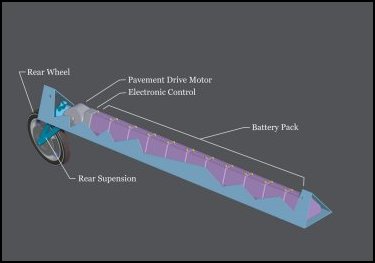
|
|
Battery Mules
Every time a TriTrack car comes down off the guideway, it picks up a different, fully charged battery mule. Each battery mule consists of a power source (likely lead-acid batteries), the rear wheel and swing arm for the car, a 10 horsepower motor that moves the car while it's on the ground, and a small computer that keeps track of power usage and the general condition of the mule. Because it takes longer for the batteries to charge than to discharge, there will be many more battery mules than there are cars on the road. Any given car will likely use thousands of different mules over its lifetime. Because the mules are exchanges so often, they cannot be personal property like the car is, and rather would be owned by the power company or city. The power source in the mule can be anything that physically fits into the space available. We propose lead-acid batteries because they are currently inexpensive and readily available. The power could come from other technology such as Lithium-ion batteries or hydrogen fuel cells. This adaptability of the power source is important for keeping the TriTrack as green as possible. The TriTrack has different power modes corresponding to the different modes of operation. |